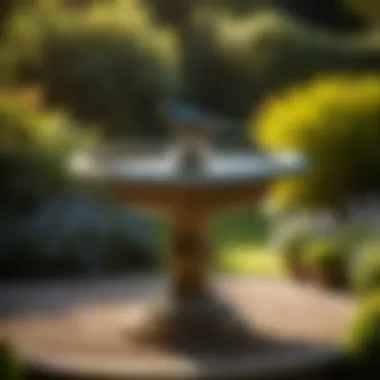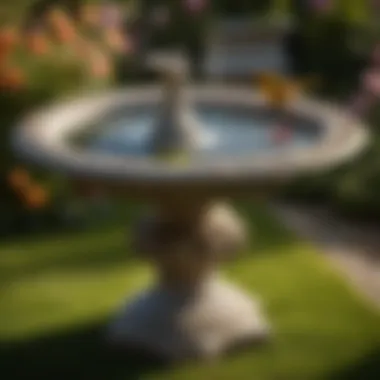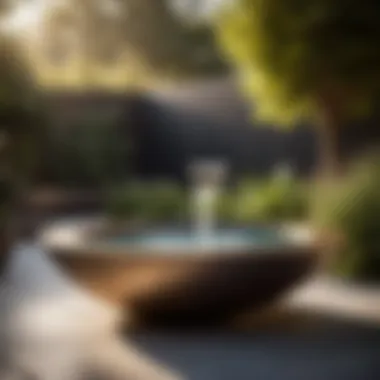Unveiling the Timeless Beauty of Traditional Bird Baths


- Concrete Bird Bath Mold: 1 unit measuring 24 inches in diameter and 3 inches deep, ensuring a sturdy structure for avian visitors to bathe in comfort and safety.
- Birdbath Pedestal: 1 unit standing at 36 inches tall, providing a stable base for the bird bath mold.
- Pebbles: 10 pounds of smooth, polished pebbles to line the bottom of the birdbath, offering a natural aesthetic and secure footing for feathered friends.
DIY Steps:
- Preparing the Workspace: Select a designated area in your garden that receives adequate sunlight and is easily accessible for you to enjoy watching the visiting birds. Clear any debris or obstacles to create a peaceful bird-friendly environment.
- Setting Up the Birdbath: Place the concrete bird bath mold on top of the birdbath pedestal, ensuring it is centered and stable. Adjust as needed to achieve the desired positioning.
- Adding Pebbles: Carefully spread the pebbles at the bottom of the bird bath mold, creating a shallow and welcoming pool for birds to land and bathe comfortably.
Technical Aspects:
- Timing: Set aside a weekend for this DIY project to allow ample time for preparation, assembly, and drying of the birdbath. Adhering to the timeline ensures a successful outcome.
- Tools Required: Level, shovel, garden hose for filling the birdbath, protective gloves, measuring tape for positioning accuracy, and a sponge for cleaning any excess water spillage.
- Critical Techniques: Ensure the bird bath mold is securely placed on the pedestal to prevent tipping or shifting. Level the mold carefully to provide an even water surface for birds to enjoy.
DIY Project Process:
- Assembly Steps: Secure the concrete bird bath mold onto the pedestal, ensuring it is level and stable. Add the pebbles to the mold bottom, creating a visually appealing and functional water source for birds.
- Filling the Birdbath: Using a garden hose, fill the birdbath with water to the desired depth, ensuring it is shallow enough for birds to bathe safely. Monitor the water level regularly to maintain cleanliness and freshness.
- Troubleshooting Tips: If the birdbath is not attracting birds, try relocating it to a different spot in your garden with more shade or offering bird feed nearby to entice feathered visitors. Ensure the water is changed frequently to prevent stagnation and bacteria growth.
Introduction
Bird baths have been a quintessential feature of gardens for centuries, drawing in avian visitors and adding a touch of elegance to outdoor spaces. In this article, we embark on a journey to uncover the essence of traditional bird baths and how they seamlessly blend functionality with aesthetic allure. From tracing their origins to understanding their significance in garden settings, this comprehensive guide will shed light on the time-honored tradition of bird baths.
Definition of Traditional Bird Baths
Origins of Bird Baths
The origins of bird baths can be traced back to ancient civilizations where they served as essential water sources for birds. The simplicity and effectiveness of these early bird baths lay the foundation for their enduring appeal in modern-day gardens. The use of natural materials like stone and clay exemplifies the organic connection these bird baths have with nature, enhancing their role in attracting various bird species.
Functionality in Garden Settings
The functionality of traditional bird baths in garden settings goes beyond mere practicality. These structures not only provide birds with a vital water source but also create a tranquil oasis in the midst of bustling greenery. The design considerations for bird baths ensure a harmonious blend with the surrounding flora, making them a sought-after feature for birdwatchers and gardening enthusiasts alike.
Historical Significance
Ancient Civilizations' Use of Bird Baths
Ancient civilizations valued the presence of birds in their surroundings and constructed bird baths to attract them closer. These early examples of bird baths symbolized a connection with nature and fostered a sense of environmental harmony. The intricate designs and cultural significance attached to these bird baths reflect a deep-rooted respect for wildlife and the preservation of avian habitats.
Symbolism and Cultural Representations


Bird baths have long been imbued with symbolism, representing purity, rebirth, and the cycle of life. Across different cultures, bird baths hold varying significance, from spiritual purification rituals to ornamental embellishments in gardens. The cultural representations associated with bird baths enrich their role beyond functional utility, turning them into meaningful artistic expressions.
Evolution of Bird Bath Designs
Materials and Construction Techniques
The evolution of bird bath designs has led to the use of diverse materials and construction techniques, resulting in a wide range of options for modern-day bird bath enthusiasts. From classic stone structures to intricately crafted metal designs, the choice of materials impacts both the aesthetic appeal and durability of bird baths. The construction techniques employed in creating these bird baths blend traditional artisanal skills with contemporary design principles, offering a seamless integration of form and function.
Aesthetic Variations Across Different Eras
The aesthetic variations in bird bath designs across different eras showcase the evolving preferences and artistic sensibilities of each period. Whether reflecting the grandeur of Victorian garden ornamentation or the simplicity of modern minimalist trends, bird baths capture the essence of their time. The diverse aesthetic expressions seen in bird bath designs cater to a wide range of tastes, ensuring that there is a bird bath style to complement any garden landscape.
Ecological Impact
In delving into the essence of traditional bird baths, it becomes evident that their ecological impact transcends mere garden aesthetics. These quintessential features play a pivotal role in sustaining avian ecosystems by providing essential water sources that attract and support various bird species. Traditional bird baths act as vital refuges for birds in urban and suburban settings where natural water sources may be scarce due to human development.
Role in Avian Ecosystems
Attracting Bird Species
Attracting Bird Species is a crucial aspect of traditional bird baths' ecological impact. By offering a reliable and accessible water source, bird baths entice diverse avian species to gardens and outdoor spaces. The gentle sound of water and the shimmering surface serve as irresistible invitations for birds, enhancing not only the visual appeal of the environment but also fostering a sense of tranquility and connection with nature.
Providing Vital Water Sources
Providing Vital Water Sources is another vital function of traditional bird baths. In regions experiencing fluctuations in rainfall or drought conditions, bird baths serve as lifelines for thirsty birds, ensuring they have access to hydration for drinking and grooming. The presence of accessible water sources also contributes to the overall health and well-being of avian populations, promoting diversity and stability within ecosystems.
Contribution to Biodiversity
Supporting Wildlife Habitats
Traditional bird baths excel in supporting wildlife habitats by creating oases of water in urban and suburban landscapes. These miniature water features attract not only birds but also insects, amphibians, and even small mammals, enriching the biodiversity of the surrounding environment. By providing a reliable source of water, bird baths play a crucial role in establishing microhabitats that support a myriad of species, ultimately contributing to the broader ecosystem's health.
Enhancing Urban Bird Populations
The presence of traditional bird baths in urban areas has shown to enhance local bird populations significantly. In settings where natural water sources have diminished due to urbanization, bird baths act as beacons for avian species, promoting nesting and foraging opportunities. By supporting urban bird populations, bird baths foster a closer relationship between humans and wildlife, encouraging positive interactions and raising awareness about the importance of supporting local biodiversity.
Sustainability Factors
Water Conservation Practices


Embracing water conservation practices is essential when incorporating traditional bird baths into outdoor spaces. By opting for designs that promote water efficiency, such as shallow basins or recirculating systems, individuals can ensure that their bird baths contribute positively to the environment without excessive water consumption. Pairing bird baths with native plants that attract wildlife can also create a sustainable ecosystem that minimizes water waste while maximizing ecological benefits.
Environmental Considerations in Bird Bath Placement
When deciding on the placement of bird baths, considering environmental factors is paramount. Placing bird baths in shaded areas can help prevent water evaporation and algae growth, maintaining water quality for avian visitors. Moreover, positioning bird baths near vegetation or bird-friendly landscaping enhances their appeal to birds while blending seamlessly with the natural surroundings. By aligning bird bath placement with environmental considerations, individuals can create harmonious outdoor spaces that prioritize both aesthetics and ecological sustainability.
Design Variations
Design variations play a crucial role in enhancing the aesthetic appeal and functionality of traditional bird baths. By incorporating intricate designs and unique features, bird baths become not just water sources for avian species but also artistic focal points in garden settings. Considerations such as materials, size, shape, and style all contribute to the overall design variations of bird baths. Understanding the importance of design variations allows homeowners and garden enthusiasts to select bird baths that not only attract birds but also complement the surrounding landscape harmoniously.
Traditional vs. Contemporary Styles
Artistic Elements in Traditional Bird Baths
Artistic elements in traditional bird baths add a touch of elegance and sophistication to outdoor spaces. From intricately carved patterns to artisanal details, traditional bird baths exude a timeless charm that resonates with classic garden aesthetics. The use of artisanal craftsmanship in traditional designs not only enhances the visual appeal but also reflects a sense of heritage and culture. While traditional styles may lack the modern flair of contemporary designs, they hold a nostalgic quality that many homeowners find endearing and comforting.
Modern Innovations in Bird Bath Design
In contrast, modern innovations in bird bath design focus on sleek lines, minimalist aesthetics, and functional features. The integration of technology, such as solar-powered water circulation systems or LED lighting, adds a contemporary touch to bird baths, making them more energy-efficient and convenient to maintain. Modern bird baths emphasize durability, ease of cleaning, and sometimes even multifunctionality, catering to the preferences of homeowners seeking a more streamlined and practical approach to bird bath ownership.
Size and Shape Considerations
Impact on Bird Attraction
The size and shape of a bird bath can significantly impact its ability to attract a diverse range of avian species. Larger bird baths with broad basins accommodate multiple birds simultaneously, creating a communal watering space that appeals to social bird species. Additionally, the depth of the basin and the presence of perching spots can make a bird bath more inviting to different bird sizes and species. Choosing the right size and shape for a bird bath is essential in maximizing its potential in attracting a variety of birds to the garden environment.
Aesthetic Integration in Garden Landscapes
The aesthetic integration of bird baths in garden landscapes is crucial for creating a cohesive and visually pleasing outdoor space. The shape and design of the bird bath should complement the overall theme of the garden, whether it's formal, English cottage, or modern minimalist. Incorporating the bird bath as a focal point or integrating it seamlessly with surrounding plantings and hardscapes enhances the visual appeal of the garden while providing a functional water source for birds. Finding a balance between aesthetics and practicality ensures that the bird bath becomes an integral part of the garden design, enhancing its overall charm and appeal.
Functional Features
Water Flow Mechanisms
Water flow mechanisms in bird baths help maintain water quality, prevent stagnation, and attract birds with the sound of running water. Features such as recirculating pumps, bubblers, or drippers not only aerate the water but also create movement that catches the attention of birds. Proper water circulation is essential for preventing mosquito breeding and algae growth, ensuring a clean and inviting environment for avian visitors. Understanding the different water flow mechanisms available allows homeowners to select a bird bath that meets both their aesthetic preferences and functional requirements.
Cleaning and Maintenance Tips
Regular cleaning and maintenance are essential to keep bird baths hygienic and attractive to birds. Using bird-safe cleaning agents and scrubbing the basin regularly help prevent the buildup of dirt, algae, and debris that can affect water quality. Establishing a routine for cleaning, especially during warmer months when bird baths are more frequently used, ensures that birds have access to clean and safe water sources. Additionally, inspecting the bird bath for any damage and performing necessary repairs promptly helps prolong its lifespan and effectiveness in supporting bird populations in the area.


Maintenance Practices
In this section of the article, we will delve into the crucial aspect of maintenance practices regarding traditional bird baths. Understanding the significance of proper maintenance is essential for ensuring the longevity and functionality of these garden features. By implementing effective maintenance strategies, individuals can preserve the beauty and functionality of their bird baths, ultimately enhancing the overall aesthetic appeal of their outdoor spaces.
Cleaning Guidelines
Frequency of Cleaning
When it comes to the frequency of cleaning traditional bird baths, consistency is key. Regular cleaning not only maintains the visual appeal of the bird bath but also promotes a healthy environment for visiting avian species. By adhering to a routine cleaning schedule, individuals can prevent the build-up of dirt, algae, and other debris that may affect the water quality. Opting for frequent cleaning intervals ensures that birds have access to clean and uncontaminated water sources, essential for their well-being.
Safe Cleaning Agents
Utilizing safe cleaning agents is paramount in maintaining traditional bird baths. When selecting cleaning solutions, it is crucial to opt for products that are environmentally friendly and non-toxic to wildlife. Avoiding harsh chemicals and opting for gentle yet effective cleaners not only protects the birds that visit the bath but also ensures the longevity of the materials used in its construction. Choosing safe cleaning agents that are specifically formulated for bird baths helps achieve a thorough clean while safeguarding the delicate ecosystem around the bath.
Seasonal Care
As the seasons change, so do the requirements for caring for traditional bird baths. Ensuring winter precautions are in place is vital to prevent damage from freezing temperatures. Individuals should consider adding heating elements or insulating materials to protect the bath during winter months. Conversely, summer maintenance tips focus on keeping the water fresh and cool to attract more avian visitors. Implementing shade structures or adding features like misters can help create a hospitable environment for birds even in hot weather.
Repair and Restoration
Understanding the common repairs needed for traditional bird baths aids in maintaining their functionality and aesthetic appeal. From repairing cracks and leaks to addressing structural issues, being aware of these common problems allows for prompt solutions. Preservation techniques for antique bird baths involve delicate care and expertise to ensure the historical integrity of these pieces. By employing conservation methods such as gentle cleaning, protective sealants, and proper storage, antique bird baths can be preserved for future generations to enjoy.
Conclusion
In delving into the essence of traditional bird baths, we unravel a tapestry of historical significance, design diversity, and ecological impact. This article serves as a comprehensive guide, shedding light on the intrinsic value that bird baths bring to our surroundings. From the origins of bird baths to their pivotal role in avian ecosystems, we have explored every facet encompassing these timeless garden features. Through this exploration, readers are encouraged to embrace and appreciate the beauty and functionality that traditional bird baths offer, highlighting their significance in both historical and modern contexts.
Enduring Appeal of Traditional Bird Baths
Timeless Beauty in Garden Settings
Traditional bird baths exude a sense of timeless beauty in garden settings, adding an aura of tranquility and charm to outdoor spaces. Their classic designs evoke a sense of nostalgia while blending seamlessly with various garden themes. The enduring appeal of traditional bird baths lies in their ability to serve as focal points that enhance the aesthetic allure of any garden. Despite advancements in design trends, the timeless beauty of traditional bird baths remains a popular choice for those seeking to create a serene and inviting outdoor oasis.
Continued Relevance in Avian Conservation Efforts
The continued relevance of traditional bird baths in avian conservation efforts cannot be overstated. As vital sources of water for feathered visitors, these fixtures play a crucial role in sustaining and supporting bird populations in urban environments. By providing essential hydration for avian species, traditional bird baths contribute significantly to maintaining biodiversity and promoting a harmonious relationship between humans and wildlife. Their enduring presence underscores their ongoing importance in fostering a thriving avian ecosystem, making them invaluable elements in conservation initiatives.
Future Prospects
Innovations in Bird Bath Technology
Discussing innovations in bird bath technology unveils a realm of possibilities for enhancing the functionality and appeal of these essential garden features. From automated water flow systems to easy-to-clean materials, technological advancements offer convenience and efficiency in bird bath maintenance. The key characteristic of these innovations lies in their ability to harmonize modern convenience with traditional charm, making them a sought-after choice for contemporary bird enthusiasts.
Preservation of Bird Bath Heritage
Preserving the heritage of traditional bird baths is crucial in safeguarding our cultural connection to these timeless artifacts. By protecting and conserving antique bird baths, we honor the craftsmanship and artistry of past eras while ensuring their legacy endures for future generations to appreciate. The unique feature of preserving bird bath heritage lies in its ability to bridge the gap between history and present-day significance, fostering a deep appreciation for the historical roots embedded within these ornate structures. Despite the challenges of maintenance and restoration, the preservation of bird bath heritage stands as a testament to our commitment to cherishing our ornithological past and nurturing it for generations to come.







